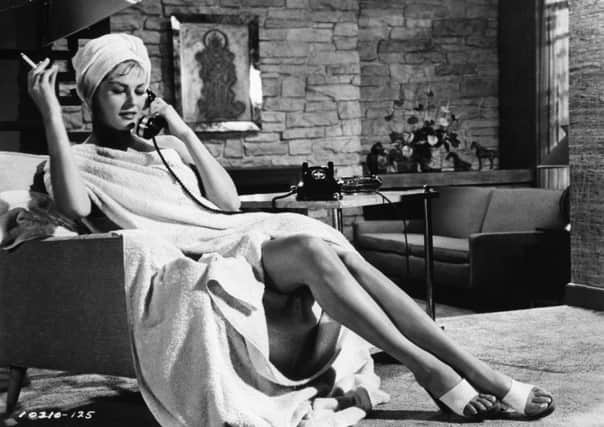Obituary: Anita Ekberg, actress


Anita Ekberg, actress.
Born: 29 September, 1931, in Malmo, Sweden.
Died: 11 January, 2015, in Rocca di Papa, Italy, aged 83.
But they would certainly recognise her in one of the most iconic scenes of European cinema in the 20th Century when she climbed into Rome’s famous Trevi Fountain in a sexy black evening dress.
Ekberg plays Sylvia, a visiting Swedish star and sex symbol, in Federico Fellini’s 1960 classic La Dolce Vita. The title, meaning the sweet life, entered common usage. The film also provided the world with a new word in paparazzi, or in the singular paparazzo, which was the name of one of the photographers who follows Sylvia about.
Advertisement
Hide AdAdvertisement
Hide AdThe film also provided an enduring series of images that justified Ekberg’s status as the original paparazzi target.
Blonde, beautiful, sensual, impossibly curvaceous, and ultimately unattainable, the Swedish-born beauty queen climbed into the fountain and lured Marcello Mastroianni’s journalist in after her.
Ekberg appeared only in the early part of the film. Mastroianni is the main star. But it is Ekberg who everyone remembers.
Her character is mobbed by press as she arrives in Rome, stepping from an Alitalia flight, her hair up, shades in place, blowing kisses to the assembly. She and Mastroianni’s character spend time together, escape the throng, and end up in the fountain. Then they return to her hotel where her fiancé gives her a slap and beats Mastroianni up.
One of eight children, Kerstin Anita Marianne Ekberg was born in Malmo, Sweden, where her father was harbourmaster. She worked as a model in her teens, won Miss Malmo and Miss Sweden titles and visited the US for the Miss Universe contest. Although she did not win, she had the consolation of a contract with Universal Studios and elocution, drama, dancing and riding lessons. One of her earliest films roles was as an alien in the 1953 comedy Abbott and Costello Go To Mars.
The following year she was sent abroad to entertain troops, along with Bob Hope, who quipped that her parents had won the Nobel Prize for architecture.
Hollywood seemed a little uncertain about how best to exploit her qualities, casting her as a Chinese woman in the John Wayne adventure film Blood Alley and then as a Russian princess in War and Peace.
She probably featured more prominently in magazines and gossip columns than she did on the screen around this time, being linked romantically with a string of leading men, including Frank Sinatra, Errol Flynn, Yul Brynner and Rod Taylor (who died last week), though she was outraged at suggestions of an affair with Victor Mature, whom she disliked intensely, calling him Victor Manure.
Advertisement
Hide AdAdvertisement
Hide AdAnd she was more than happy to take part in publicity stunts, including one that would now be termed a “wardrobe malfunction”, with a photographer standing by to capture the moment.
Her acting hardly troubled Oscar voters, but she was undoubtedly a major celebrity by the time she made La Dolce Vita. Riot police were needed to control the crowds when she married the English actor Anthony Steel in Florence in 1956. The marriage lasted only a few years.
Fellini’s genius was in getting her to play herself, which is why the role and the film worked so well.
Over the next few years she went on to share star billing in Call Me Bwana with Bob Hope and in the comedy Western 4 for Texas with Frank Sinatra, Dean Martin and Ursula Andress, to whom she lost out for the role of Honey Ryder in the first James Bond film Dr No.
In 1963 she married for a second time to Rik Van Nutter, an American actor, best known for playing the CIA agent Felix Leiter in the James Bond film Thunderball. They set up a shipping business together, but the marriage ended in a messy divorce. Ekberg accused him of stealing her villa, yacht and Ferrari.
Ekberg never found another role to rival Sylvia in La Dolce Vita and within a decade she had more or less retired from films.
But the image of her showering in the fountain remained seared in the public consciousness – an alluring figure on a level somewhat less than intellectual.
With her hair down, her eyes closed, her lips pouting, she was the modern siren, a look on her face that might be described as enigmatic or perhaps less charitably as completely vacant – a symbol of the film’s themes.
Advertisement
Hide AdAdvertisement
Hide AdThere was nothing romantic or erotic about the shooting of the scene, which was done in the depths of winter. Mastroianni sustained himself with copious quantities of vodka and Ekberg was so cold by the end of it that she lost all feeling in her legs and had to be lifted from the fountain.
In later life Ekberg said she preferred the company of dogs to men. And in recent years she was confined to a wheelchair after being knocked over by one of her Great Danes and breaking a hip.
It was also reported a few years ago that she was “destitute” following a prolonged stay in hospital, during which her home in Italy was burgled. She had no children.
BRIAN PENDREIGH